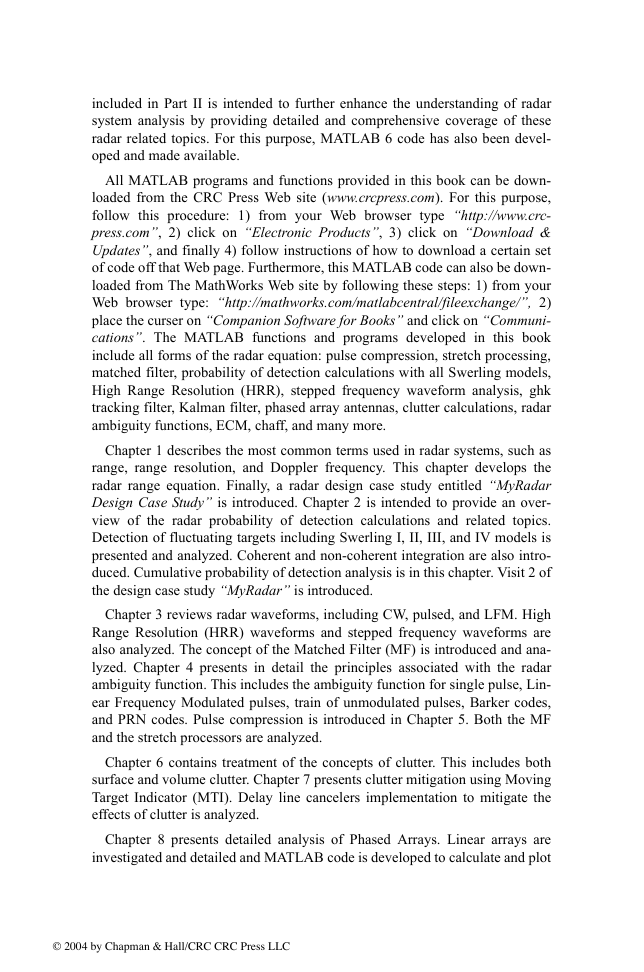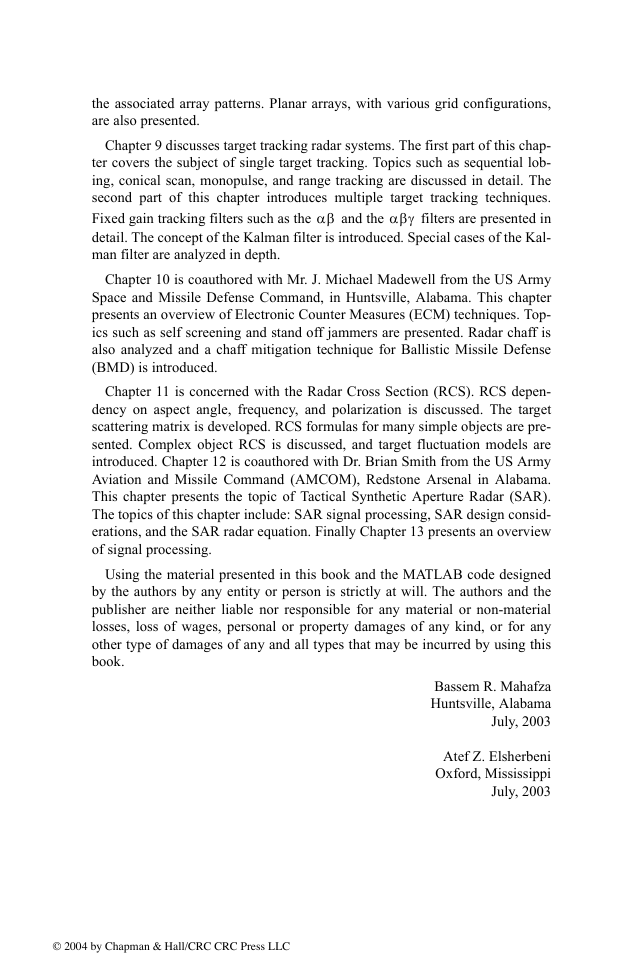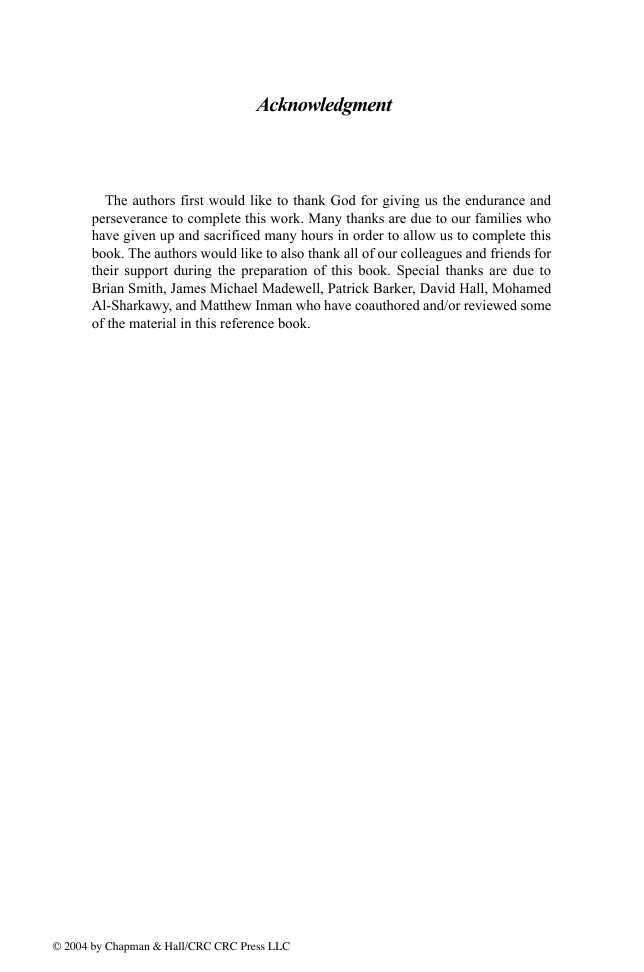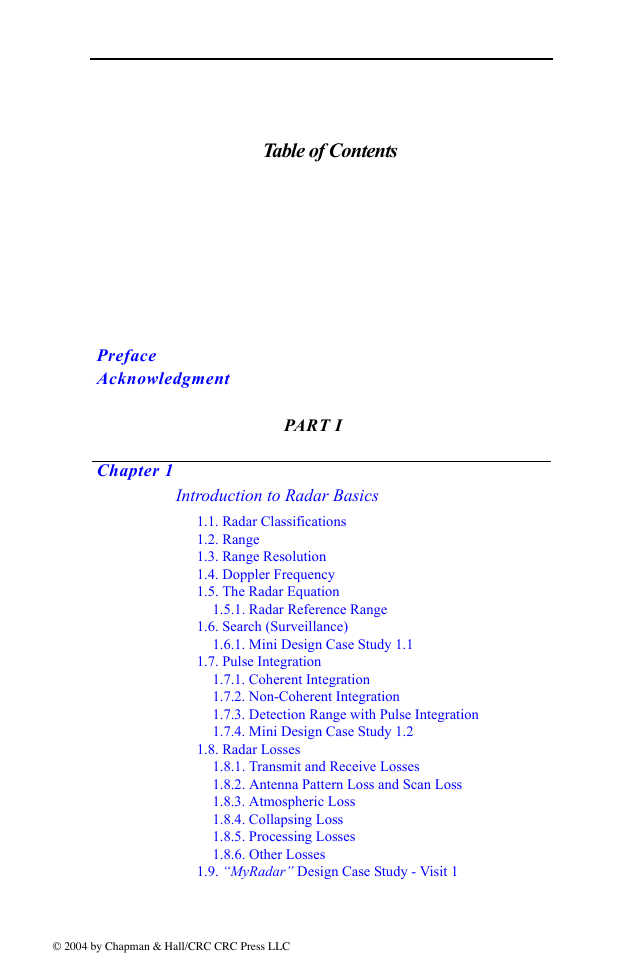c3928_fm.pdf
MATLAB Simulations for Radar Systems Design
Preface
Acknowledgment
Table of Contents
C3928_ch 01.pdf
MATLAB Simulations for Radar Systems Design
Contents
Chapter 1 Introduction to Radar Basics
1.1. Radar Classifications
1.2. Range
1.3. Range Resolution
1.4. Doppler Frequency
1.5. The Radar Equation
1.5.1. Radar Reference Range
1.6. Search (Surveillance)
1.6.1. Mini Design Case Study 1.1
1.7. Pulse Integration
1.7.1. Coherent Integration
1.7.2. Non-Coherent Integration
1.7.3. Detection Range with Pulse Integration
1.7.4. Mini Design Case Study 1.2
1.8. Radar Losses
1.8.1. Transmit and Receive Losses
1.8.2. Antenna Pattern Loss and Scan Loss
1.8.3. Atmospheric Loss
1.8.4. Collapsing Loss
1.8.5. Processing Losses
1.8.6. Other Losses
1.9. “MyRadar” Design Case Study - Visit 1
1.9.1. Authors and Publisher Disclaimer
1.9.2. Problem Statement
1.9.3. A Design
1.9.4. A Design Alternative
1.10. MATLAB Program and Function Listings
Listing 1.1. MATLAB Function “radar_eq.m”
Listing 1.2. MATLAB Program “fig1_12.m”
Listing 1.3. MATLAB Program “fig1_13.m”
Listing 1.4. MATLAB Program “ref_snr.m”
Listing 1.5. MATLAB Function “power_aperture.m”
Listing 1.6. MATLAB Program “fig1_16.m”
Listing 1.7. MATLAB Program “casestudy1_1.m”
Listing 1.8. MATLAB Program “fig1_19.m”
Listing 1.9. MATLAB Program “fig1_21.m”
Listing 1.10. MATLAB Function “pulse_integration.m”
Listing 1.11. MATLAB Program “myradarvisit1_1.m”
Listing 1.12. MATLAB Program “fig1_27.m”
Appendix 1A Pulsed Radar
1A.1. Introduction
1A.2. Range and Doppler Ambiguities
1A.3. Resolving Range Ambiguity
1A.4. Resolving Doppler Ambiguity
Appendix 1B Noise Figure
1B.1. Noise Figure
C3928_ch 02.pdf
MATLAB Simulations for Radar Systems Design
Contents
Chapter 2 Radar Detection
2.1. Detection in the Presence of Noise
2.2. Probability of False Alarm
2.3. Probability of Detection
2.4. Pulse Integration
2.4.1. Coherent Integration
2.4.2. Non-Coherent Integration
2.5. Detection of Fluctuating Targets
2.5.1. Threshold Selection
2.6. Probability of Detection Calculation
2.6.1. Detection of Swerling V Targets
2.6.2. Detection of Swerling I Targets
2.6.3. Detection of Swerling II Targets
2.6.4. Detection of Swerling III Targets
2.6.5. Detection of Swerling IV Targets
2.7. The Radar Equation Revisited
2.8. Cumulative Probability of Detection
2.8.1. Mini Design Case Study 2.2
2.9. Constant False Alarm Rate (CFAR)
2.9.1. Cell-Averaging CFAR (Single Pulse)
2.9.2. Cell-Averaging CFAR with Non-Coherent Integration
2.10. “MyRadar” Design Case Study - Visit 2
2.10.1. Problem Statement
2.10.2. A Design
2.10.2.1 Single Pulse (Per Frame) Design Option
2.10.2.2. Non-Coherent Integration Design Option
2.11. MATLAB Program and Function Listings
Listing 2.1. MATLAB Program “fig2_2.m”
Listing 2.2. MATLAB Function “que_func.m”
Listing 2.3. MATLAB Program “fig2_3.m”
Listing 2.4. MATLAB Function “marcumsq.m”
Listing 2.5. MATLAB Program “prob_snr1.m”
Listing 2.6. MATLAB program “fig2_6a.m”
Listing 2.7. MATLAB Function “improv_fac.m”
Listing 2.8. MATLAB Program “fig2_6b.m”
Listing 2.9. MATLAB Function “incomplete_gamma.m”
Listing 2.10. MATLAB Function “factor.m”
Listing 2.11. MATLAB Program “fig2_7.m”
Listing 2.12. MATLAB Function “threshold.m”
Listing 2.13. MATLAB Program “fig2_8.m”
Listing 2.14. MATLAB Function “pd_swerling5.m”
Listing 2.15. MATLAB Program “fig2_9.m”
Listing 2.16. MATLAB Function “pd_swerling1.m”
Listing 2.17. MATLAB Program “fig2_10.m”
Listing 2.18. MATLAB Program “fig2_11ab.m”
Listing 2.19. MATLAB Function “pd_swerling2.m”
Listing 2.20. MATLAB Program “fig2_12.m”
Listing 2.21. MATLAB Function “pd_swerling3.m”
Listing 2.22. MATLAB Program “fig2_13.m”
Listing 2.23. MATLAB Function “pd_swerling4.m”
Listing 2.24. MATLAB Program “fig2_14.m”
Listing 2.25. MATLAB Function “fluct_loss.m”
Listing 2.26. MATLAB Program “fig2_15.m”
Listing 2.27. MATLAB Program “myradar_visit2_1.m”
Listing 2.28. MATLAB Program “myradar_visit2_2.m”
Listing 2.29. MATLAB Program “fig2_21.m”
C3928_ch 03.pdf
MATLAB Simulations for Radar Systems Design
Contents
Chapter 3 Radar Waveforms
3.1. Low Pass, Band Pass Signals, and Quadrature Components
3.2. The Analytic Signal
3.3. CW and Pulsed Waveforms
3.4. Linear Frequency Modulation Waveforms
3.5. High Range Resolution
3.6. Stepped Frequency Waveforms
3.6.1. Range Resolution and Range Ambiguity in SFW
3.6.2. Effect of Target Velocity
3.7. The Matched Filter
3.8. The Replica
3.9. Matched Filter Response to LFM Waveforms
3.10. Waveform Resolution and Ambiguity
3.10.1. Range Resolution
3.10.2. Doppler Resolution
3.10.3. Combined Range and Doppler Resolution
3.11. “MyRadar” Design Case Study - Visit 3
3.11.1. Problem Statement
3.11.2. A Design
3.12. MATLAB Program and Function Listings
Listing 3.1. MATLAB Program “fig3_7.m”
Listing 3.2. MATLAB Program “fig3_8.m”
Listing 3.3. MATLAB Function “hrr_profile.m”
Listing 3.4. MATLAB Program “fig3_17.m”
C3928_ch 04.pdf
MATLAB Simulations for Radar Systems Design
Contents
Chapter 4 The Radar Ambiguity Function
4.1. Introduction
4.2. Examples of the Ambiguity Function
4.2.1. Single Pulse Ambiguity Function
4.2.2. LFM Ambiguity Function
4.2.3. Coherent Pulse Train Ambiguity Function
4.3. Ambiguity Diagram Contours
4.4. Digital Coded Waveforms
4.4.1. Frequency Coding (Costas Codes)
4.4.2. Binary Phase Codes
4.4.3. Pseudo-Random Number (PRN) Codes
4.5. “MyRadar” Design Case Study - Visit 4
4.5.1. Problem Statement
4.5.2. A Design
4.6. MATLAB Program and Function Listings
Listing 4.1. MATLAB Function “single_pulse_ambg.m”
Listing 4.2. MATLAB Program “fig4_2.m”
Listing 4.3. MATLAB Program “fig4_4.m”
Listing 4.4. MATLAB Function “lfm_ambg.m”
Listing 4.5. MATLAB Program “fig4_5.m”
Listing 4.6. MATLAB Program “fig4_6.m”
Listing 4.7. MATLAB Function “train_ambg.m”
Listing 4.8. MATLAB Program “fig4_8.m”
Listing 4.9. MATLAB Function “barker_ambig.m”
Listing 4.10. MATLAB Function “prn_ambig.m”
Listing 4.11. MATLAB Program “myradar_visit4.m”
C3928_ch 05.pdf
MATLAB Simulations for Radar Systems Design
Contents
Chapter 5 Pulse Compression
5.1. Time-Bandwidth Product
5.2. Radar Equation with Pulse Compression
5.3. LFM Pulse Compression
5.3.1. Correlation Processor
5.3.2. Stretch Processor
5.3.3. Distortion Due to Target Velocity
5.4. “MyRadar” Design Case Study - Visit 5
5.4.1. Problem Statement
5.4.2. A Design
5.5. MATLAB Program and Function Listings
Listing 5.1. MATLAB Program “fig5_3.m”
Listing 5.2. MATLAB Function “matched_filter.m”
Listing 5.3. MATLAB Function “power_integer_2.m”
Listing 5.4. MATLAB Function “stretch.m”
Listing 5.5. MATLAB Program “fig5_14.m”
C3928_ch 06.pdf
MATLAB Simulations for Radar Systems Design
Contents
Chapter 6 Surface and Volume Clutter
6.1. Clutter Definition
6.2. Surface Clutter
6.2.1. Radar Equation for Area Clutter - Airborne Radar
6.2.2. Radar Equation for Area Clutter - Ground Based Radar
6.3. Volume Clutter
6.3.1. Radar Equation for Volume Clutter
6.4. Clutter Statistical Models
6.5. “MyRadar” Design Case Study - Visit 6
6.5.1. Problem Statement
6.5.2. A Design
6.6. MATLAB Program and Function Listings
Listing 6.1. MATALB Function “clutter_rcs.m”
Listing 6.2. MATLAB Program “myradar_visit6.m”
C3928_ch 07.pdf
MATLAB Simulations for Radar Systems Design
Contents
Chapter 7 Moving Target Indicator (MTI) and Clutter Mitigation
7.1. Clutter Spectrum
7.2. Moving Target Indicator (MTI)
7.3. Single Delay Line Canceler
7.4. Double Delay Line Canceler
7.5. Delay Lines with Feedback (Recursive Filters)
7.6. PRF Staggering
7.7. MTI Improvement Factor
7.7.1. Two-Pulse MTI Case
7.7.2. The General Case
7.8. “MyRadar” Design Case Study - Visit 7
7.8.1. Problem Statement
7.8.2. A Design
7.9. MATLAB Program and Function Listings
Listing 7.1. MATLAB Function “single_canceler.m”
Listing 7.2. MATLAB Function “double_canceler.m”
Listing 7.3. MATLAB Program “fig7_9.m”
Listing 7.4. MATLAB Program “fig7_10.m”
Listing 7.5. MATLAB Program “fig7_11.m”
Listing 7.6. MATLAB Program “myradar_visit7.m”
C3928_ch 08.pdf
MATLAB Simulations for Radar Systems Design
Contents
Chapter 8 Phased Arrays
8.1. Directivity, Power Gain, and Effective Aperture
8.2. Near and Far Fields
8.3. General Arrays
8.4. Linear Arrays
8.4.1. Array Tapering
8.4.2. Computation of the Radiation Pattern via the DFT
8.5. Planar Arrays
8.6. Array Scan Loss
8.7. “MyRadar” Design Case Study - Visit 8
8.7.1. Problem Statement
8.7.2. A Design
8.8. MATLAB Program and Function Listings
Listing 8.1. MATLAB Program “fig8_5.m”
Listing 8.2. MATLAB Program “fig8_7.m”
Listing 8.3. MATLAB Function “linear_array.m”
Listing 8.4. MATLAB Program “circular_array.m”
Listing 8.5. MATLAB Function “rect_array.m”
Listing 8.6. MATLAB Function “circ_array.m”
Listing 8.7. MATLAB Function “rec_to_circ.m”
Listing 8.8. MATLAB Program “fig8_52.m”
C3928_ch 09.pdf
MATLAB Simulations for Radar Systems Design
Contents
Chapter 9 Target Tracking
9.1. Angle Tracking
9.1.1. Sequential Lobing
9.1.2. Conical Scan
9.2. Amplitude Comparison Monopulse
9.3. Phase Comparison Monopulse
9.4. Range Tracking
9.5. Track-While-Scan (TWS)
9.6. State Variable Representation of an LTI System
9.7. The LTI System of Interest
9.8. Fixed-Gain Tracking Filters
9.9. The Kalman Filter
9.9.1. The Singer -Kalman Filter
9.9.2. Relationship between Kalman and Filters
9.10. “MyRadar” Design Case Study - Visit 9
9.10.1. Problem Statement
9.10.2. A Design
9.11. MATLAB Program and Function Listings
Listing 9.1. MATLAB Function “mono_pulse.m”
Listing 9.2. MATLAB Function “ghk_tracker.m”
Listing 9.3. MATLAB Program “fig9_21.m”
Listing 9.4. MATLAB Function “kalman_filter.m”
Listing 9.5. MATLAB Program “fig9_28.m”
Listing 9.6. MATLAB Function “maketraj.m”
Listing 9.7. MATLAB Function “addnoise.m”
Listing 9.8. MATLAB Function “kalfilt.m”
C3928_ch 10.pdf
MATLAB Simulations for Radar Systems Design
Contents
Chapter 10 Electronic Countermeasures (ECM)
10.1. Introduction
10.2. Jammers
10.2.1. Self-Screening Jammers (SSJ)
10.2.2. Stand-Off Jammers (SOJ)
10.3. Range Reduction Factor
10.4. Chaff
10.4.1. Multiple MTI Chaff Mitigation Technique
10.5. MATLAB Program and Function Listings
Listing 10.1. MATLAB Function “ssj_req.m”
Listing 10.2. MATLAB Function “sir.m”
Listing 10.3. MATLAB Function “burn_thru.m”
Listing 10.4. MATLAB Function “soj_req.m”
Listing 10.5. MATLAB Function “range_red_factor.m”
Listing 10.6. MATLAB Program “fig10_8.m”
C3928_ch 11.pdf
MATLAB Simulations for Radar Systems Design
Contents
Chapter 11 Radar Cross Section (RCS)
11.1. RCS Definition
11.2. RCS Prediction Methods
11.3. Dependency on Aspect Angle and Frequency
11.4. RCS Dependency on Polarization
11.4.1. Polarization
11.4.2. Target Scattering Matrix
11.5. RCS of Simple Objects
11.5.1. Sphere
11.5.2. Ellipsoid
11.5.3. Circular Flat Plate
11.5.4. Truncated Cone (Frustum)
11.5.5. Cylinder
11.5.6. Rectangular Flat Plate
11.5.7. Triangular Flat Plate
11.6. Scattering From a Dielectric-Capped Wedge
11.6.1. Far Scattered Field
11.6.2. Plane Wave Excitation
11.6.3. Special Cases
11.7. RCS of Complex Objects
11.8. RCS Fluctuations and Statistical Models
11.8.1. RCS Statistical Models - Scintillation Models
11.9. MATLAB Program and Function Listings
Listing 11.1. MATLAB Function “rcs_aspect.m”
Listing 11.2. MATLAB Function “rcs_frequency.m”
Listing 11.3. MATLAB Program “example11_1.m”
Listing 11.4. MATLAB Program “rcs_sphere.m”
Listing 11.5. MATLAB Function “rcs_ellipsoid.m”
Listing 11.6. MATLAB Program “fig11_18a.m”
Listing 11.7. MATLAB Function “rcs_circ_plate.m”
Listing 11.8. MATLAB Function “rcs_frustum.m”
Listing 11.9. MATLAB Function “rcs_cylinder.m”
Listing 11.10. MATLAB Function “rcs_rect_plate.m”
Listing 11.11. MATLAB Function “rcs_isosceles.m”
Listing 11.12. MATLAB Program “Capped_WedgeTM.m”
Listing 11.13. MATLAB Function "DielCappedWedgeTMFields_Ls.m"
Listing 11.14. MATLAB Function "DielCappedWedgeTMFields_PW.m"
Listing 11.15. MATLAB Function "polardb.m"
Listing 11.16. MATLAB Function "dbesselj.m"
Listing 11.17. MATLAB Function "dbessely.m"
Listing 11.18. MATLAB Function "dbesselh.m"
Listing 11.19. MATLAB Program “rcs_cylinder_complex.m”
Listing 11.20. MATLAB Program “Swerling_models.m”
C3928_ch 12.pdf
MATLAB Simulations for Radar Systems Design
Contents
Chapter 12 High Resolution Tactical Synthetic Aperture Radar (TSAR)
12.1. Introduction
12.2. Side Looking SAR Geometry
12.3. SAR Design Considerations
12.4. SAR Radar Equation
12.5. SAR Signal Processing
12.6. Side Looking SAR Doppler Processing
12.7. SAR Imaging Using Doppler Processing
12.8. Range Walk
12.9. A Three-Dimensional SAR Imaging Technique
12.9.1. Background
12.9.2. DFTSQM Operation and Signal Processing
12.9.3. Geometry for DFTSQM SAR Imaging
12.9.4. Slant Range Equation
12.9.5. Signal Synthesis
12.9.6. Electronic Processing
12.9.7. Derivation of Eq. (12.71)
12.9.8. Non-Zero Taylor Series Coefficients for the kth Range Cell
12.10. MATLAB Programs and Functions
Listing 12.1. MATLAB Program “fig12_12-13.m”
C3928_ch 13.pdf
MATLAB Simulations for Radar Systems Design
Contents
Chapter 13 Signal Processing
13.1. Signal and System Classifications
13.2. The Fourier Transform
13.3. The Fourier Series
13.4. Convolution and Correlation Integrals
13.5. Energy and Power Spectrum Densities
13.6. Random Variables
13.7. Multivariate Gaussian Distribution
13.8. Random Processes
13.9. Sampling Theorem
13.10. The Z-Transform
13.11. The Discrete Fourier Transform
13.12. Discrete Power Spectrum
13.13. Windowing Techniques
13.14. MATLAB Programs
Appendix 13A Fourier Transform Table
Appendix 13B Some Common Probability Densities
Appendix 13C Z - Transform Table
C3928_ch 14.pdf
MATLAB Simulations for Radar Systems Design
Contents
Chapter 14 MATLAB Program and Function Name List
Chapter 1: Introduction to Radar Basics
Chapter 2: Radar Detection
Chapter 3: Radar Waveforms
Chapter 4: The Radar Ambiguity Function
Chapter 5: Pulse Compression
Chapter 6: Surface and Volume Clutter
Chapter 7: Moving Target Indicator (MTI) - Clutter Mitigation
Chapter 8: Phased Arrays
Chapter 9: Target Tracking
Chapter 10: Electronic Countermeasures (ECM)
Chapter 11: Radar Cross Section (RCS)
Chapter 12: High Resolution Tactical Synthetic Aperture Radar (TSAR)
Chapter 13: Signal Processing
C3928_bib.pdf
MATLAB Simulations for Radar Systems Design
Contents
Bibliography
















 2023年江西萍乡中考道德与法治真题及答案.doc
2023年江西萍乡中考道德与法治真题及答案.doc 2012年重庆南川中考生物真题及答案.doc
2012年重庆南川中考生物真题及答案.doc 2013年江西师范大学地理学综合及文艺理论基础考研真题.doc
2013年江西师范大学地理学综合及文艺理论基础考研真题.doc 2020年四川甘孜小升初语文真题及答案I卷.doc
2020年四川甘孜小升初语文真题及答案I卷.doc 2020年注册岩土工程师专业基础考试真题及答案.doc
2020年注册岩土工程师专业基础考试真题及答案.doc 2023-2024学年福建省厦门市九年级上学期数学月考试题及答案.doc
2023-2024学年福建省厦门市九年级上学期数学月考试题及答案.doc 2021-2022学年辽宁省沈阳市大东区九年级上学期语文期末试题及答案.doc
2021-2022学年辽宁省沈阳市大东区九年级上学期语文期末试题及答案.doc 2022-2023学年北京东城区初三第一学期物理期末试卷及答案.doc
2022-2023学年北京东城区初三第一学期物理期末试卷及答案.doc 2018上半年江西教师资格初中地理学科知识与教学能力真题及答案.doc
2018上半年江西教师资格初中地理学科知识与教学能力真题及答案.doc 2012年河北国家公务员申论考试真题及答案-省级.doc
2012年河北国家公务员申论考试真题及答案-省级.doc 2020-2021学年江苏省扬州市江都区邵樊片九年级上学期数学第一次质量检测试题及答案.doc
2020-2021学年江苏省扬州市江都区邵樊片九年级上学期数学第一次质量检测试题及答案.doc 2022下半年黑龙江教师资格证中学综合素质真题及答案.doc
2022下半年黑龙江教师资格证中学综合素质真题及答案.doc